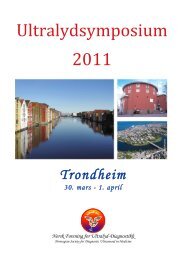Ultralydsymposium - NORSK FORENING FOR ULTRALYD ...
Ultralydsymposium - NORSK FORENING FOR ULTRALYD ...
Ultralydsymposium - NORSK FORENING FOR ULTRALYD ...
- No tags were found...
Create successful ePaper yourself
Turn your PDF publications into a flip-book with our unique Google optimized e-Paper software.
Ultrasound and labourTorbjørn Moe EggebøDepartement of obstetrics, Stavanger University HospitalSafe obstetrics depends on good routines managing difficult labours and to avoidunnecessary interventions. Labour is a complicated process, and the fetus has to rotatethrough the birth canal. The four cardinal movements are flexion, rotation, deflection androtation in a normal labour. However, the third cardinal movement is first maximal flexionfollowed by deflection for fetuses in occiput posterior position. Better diagnoses of labourprogress are a key point, and ultrasound during labour is shown to be helpful. Determiningfetal position is easy using ultrasound. The clinical value of diagnosing position is limitedin the first stage of labour because most fetuses rotate spontaneously even though thelabour starts in an occiput position. However, in the second stage, and especially before anoperative vaginal delivery, exact knowledge related to position is essential.Head descent can also be assessed with ultrasound. Several methods are suggested.First Dietz published a method called progression distance. The method is too complicatedfor clinical use, and Barbera suggested a similar but simpler method; the angle ofprogression (Figure 1). This method predicts the probability of a successful operativevaginal delivery. Henrich has assessed the direction of the fetal head and suggested to usethe ”head up” sign as a prognostic positive factor.In Stavanger we have focused on labour dystocia in the first stage of labour and suggestedto measure the shortest distance from fetal head to perineum (Figure 2). Torkildsen hasdocumented that this method predicts the probability of a successful vaginal delivery inprimiparous women with prolonged first stage of labour.This lecture will demonstrate different ultrasound methods, and present results fromscientific studies investigating ultrasound in labour. We believe that ultrasound in laborwill become important in future obstetrics. However, there is a need for more studies, andwe recommend researchers all over the world to take part in this new and exciting area ofultrasound use.Figur 1. Angle of progressionFigur 2. Head-perineum distance











